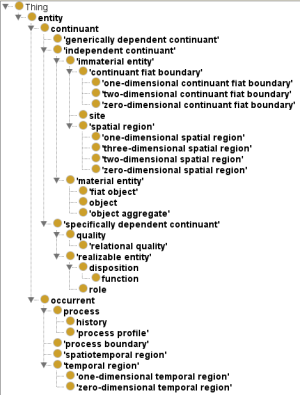Basic formal ontology: Difference between revisions
Jump to navigation
Jump to search
No edit summary |
|||
| (3 intermediate revisions by the same user not shown) | |||
| Line 1: | Line 1: | ||
[[File:BFO2.png|thumb|Basic formal ontology]] | |||
= | =[[Definition]]= | ||
Basic formal ontology is a small, upper-level ontology. | |||
<ref>[https://github.com/bfo-ontology/BFO/wiki Website Basic formal ontology]</ref> | |||
=[[Note]]s= | |||
* It is is designed for use in supporting information retrieval, analysis and integration in scientific and other domains. | * It is is designed for use in supporting information retrieval, analysis and integration in scientific and other domains. | ||
* It does not contain physical, chemical, biological or other terms which would properly fall within the coverage domains of the special sciences. | * It does not contain physical, chemical, biological or other terms which would properly fall within the coverage domains of the special sciences. | ||
= | =[[Abbreviation]]s= | ||
BFO | BFO | ||
= | =[[Generic relation]]s= | ||
[[Superordinate concept]] is: | [[Superordinate concept]] is: | ||
* [[Ontology]] | * [[Ontology]] | ||
= | =[[Reference]]s= | ||
[[Category:All]] | [[Category:All]] | ||
Latest revision as of 14:09, 30 December 2022
Definition
Basic formal ontology is a small, upper-level ontology. [1]
Notes
- It is is designed for use in supporting information retrieval, analysis and integration in scientific and other domains.
- It does not contain physical, chemical, biological or other terms which would properly fall within the coverage domains of the special sciences.
Abbreviations
BFO
